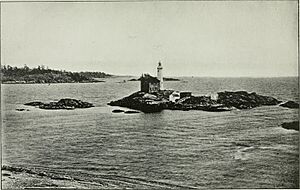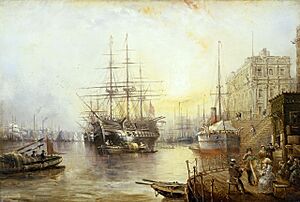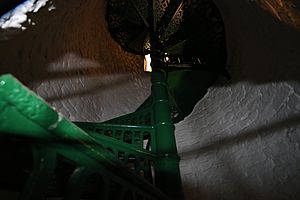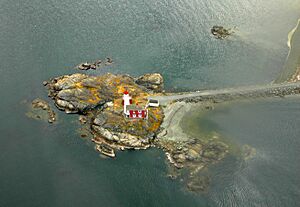Fisgard Lighthouse National Historic Site facts for kids
| Location | Esquimalt Harbour, British Columbia, Canada |
|---|---|
| Coordinates | 48°25′49.4″N 123°26′51.4″W / 48.430389°N 123.447611°W |
| Year first constructed | 1859–1860 |
| Year first lit | 16 November 1860 |
| Automated | 1929 |
| Foundation | granite |
| Construction | bricks |
| Tower shape | tapered cylindrical tower with balcony and lantern |
| Markings / pattern | white tower, red lantern |
| Height | 14.6 m (48 ft) |
| Focal height | 21.6 m (71 ft) |
| Original lens | Fourth-order Fresnel lens |
| Characteristic | Iso WR 4s. |
Fisgard Lighthouse National Historic Site is home to Fisgard Lighthouse. This famous lighthouse stands on Fisgard Island at the entrance to Esquimalt Harbour in Colwood, British Columbia. It was the very first lighthouse built on the west coast of Canada.
The British government of the Colony of Vancouver Island built the lighthouse between 1859 and 1860. Its light first shone on November 16, 1860. Twelve different lighthouse keepers worked there full-time. In 1929, the lighthouse became automated, meaning it could run by itself. It has been working ever since, except for about a year after a fire in 1957.
The light from Fisgard Lighthouse shines white for two seconds in one direction. In other directions, it shows red. The white tower is about 14.6 meters (48 feet) tall. The light itself is 21.6 meters (71 feet) above the average sea level.
Fisgard Lighthouse was officially named a National Historic Site of Canada on November 3, 1958. In the 1950s, a path called a causeway was built. This causeway connects Fisgard Island to Fort Rodd Hill National Historic Site. Both sites are now managed together by Parks Canada.
Contents
History of Fisgard Lighthouse
Why the Lighthouse Was Built
Fisgard Lighthouse and another lighthouse called Race Rocks Light were built between 1859 and 1860. They helped naval ships safely enter Esquimalt Harbour. They also guided merchant ships into Victoria Harbour.
Building these lighthouses showed that the British government was serious about supporting the Colony of Vancouver Island. This was important because many American gold miners were coming to the area. About 25,000 miners arrived in 1858 for the Fraser Gold Rush.
Colonial Governor James Douglas asked the British government to build the lighthouse. Captain George Richards agreed with him. He suggested building a lighthouse at the mouth of Esquimalt Harbour. Fisgard Island was chosen as the spot for the new lighthouse. The island was named after HMS Fisgard. This British Navy ship had explored the island in 1848.
Building the Lighthouse (1859–1860)
Architects John Wright and Hermann Otto Tiedemann designed the lighthouse. They also designed the pretty red brick house next to it. Joseph Despard Pemberton, a colonial surveyor, was given the job to build the lighthouse. Work on Fisgard Island started in the fall of 1859.
Some people used to say that the bricks and stones for the lighthouse came all the way from Britain. But actually, local brick yards and quarries provided these materials. The buildings were finished by June 1860. The first lighthouse keeper, Mr. George Davies, brought the lens, lamp, and lantern room from England in 1859. The spiral staircase inside the tower was made of cast-iron. Its parts were made in San Francisco.
How the Lighthouse Worked (1860–1928)

Fisgard Lighthouse first turned on its light at sunset on November 16, 1860.
After 1897, strong guns at the nearby Fort Rodd Hill caused cracks in the lantern windows. So, permanent steel covers were added to the side of the lantern room facing the land. George Johnson was the last keeper who lived full-time at Fisgard. Josiah Gosse, the final keeper, had permission to live nearby on Esquimalt Lagoon. He would row out to Fisgard every evening to tend to the light.
Later Years of the Lighthouse
In the early 1940s, the lighthouse's acetylene lamp was replaced. A new electric light powered by batteries was installed. Between 1950 and 1951, the Canadian Armed Forces built a causeway. This causeway connected Fisgard Island to the shore at Fort Rodd Hill. It was meant to be a military barrier. But it also gave direct access to Fisgard Lighthouse.
In 1957, a fire broke out inside the lighthouse. It might have been caused by vandalism. The fire badly damaged the inside of the lighthouse. Only the checkered floors and steel staircase were left. The interior was repaired. The next year, the lighthouse and the keeper's house were named a National Historic Site. Parks Canada then took over managing the site.
Visiting Fisgard Lighthouse
You can reach Fisgard Lighthouse by land using the causeway. This causeway starts from the nearby Fort Rodd Hill National Historic Site.
The old house where the lighthouse keeper lived is open to visitors. Inside, you can see displays and learn about the history of the site. The lighthouse tower itself is still working to guide ships. Because of this, it is not open to the public.
Important Historical Status
The lighthouse was named a National Historic Site of Canada in 1958. It is also recognized as a Classified Federal Heritage Building.
Lighthouse Keepers
From 1860 until 1928, twelve different people worked as the lighthouse keeper:
- George Davies, 1860–1861
- John Watson, 1861
- William H. Bevis, 1861–1879 (He passed away while on duty in 1879)
- Amelia Bevis, 1879–1880
- Henry Cogan, 1880–1884
- Joseph Dare, 1884–1898 (He drowned in Esquimalt Harbour in 1898)
- W. Cormack, 1898
- John Davies, 1898
- Douglas MacKenzie, 1898–1900
- Andrew Deacon, 1900–1901
- George Johnson, 1901–1909
- Josiah Gosse, 1909–1928
See also
- List of lighthouses in British Columbia
- List of lighthouses in Canada
- Fort Rodd Hill National Historic Site




